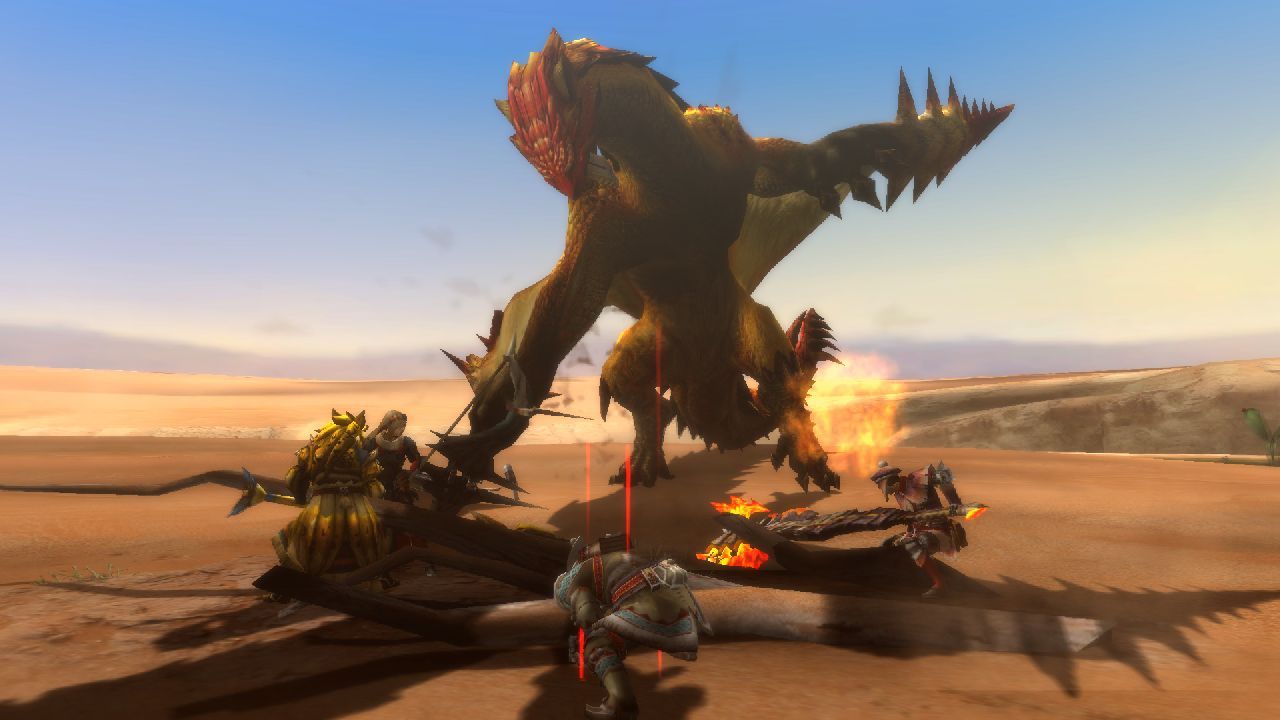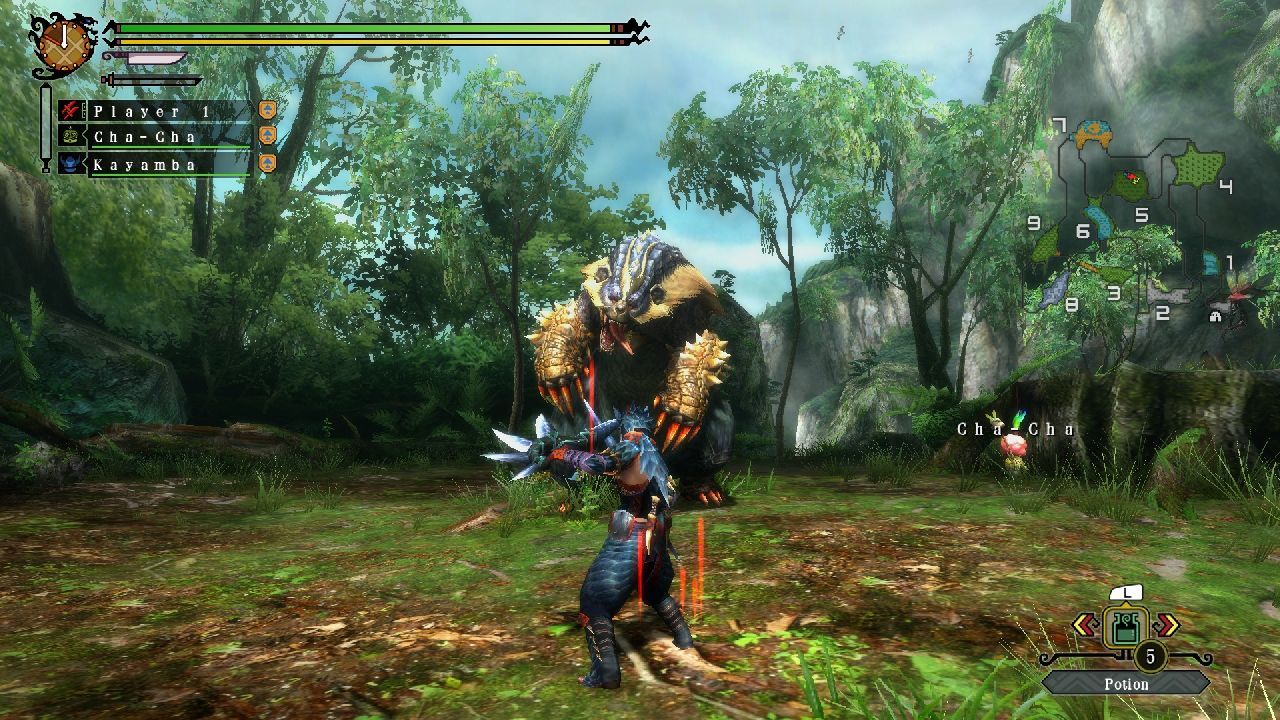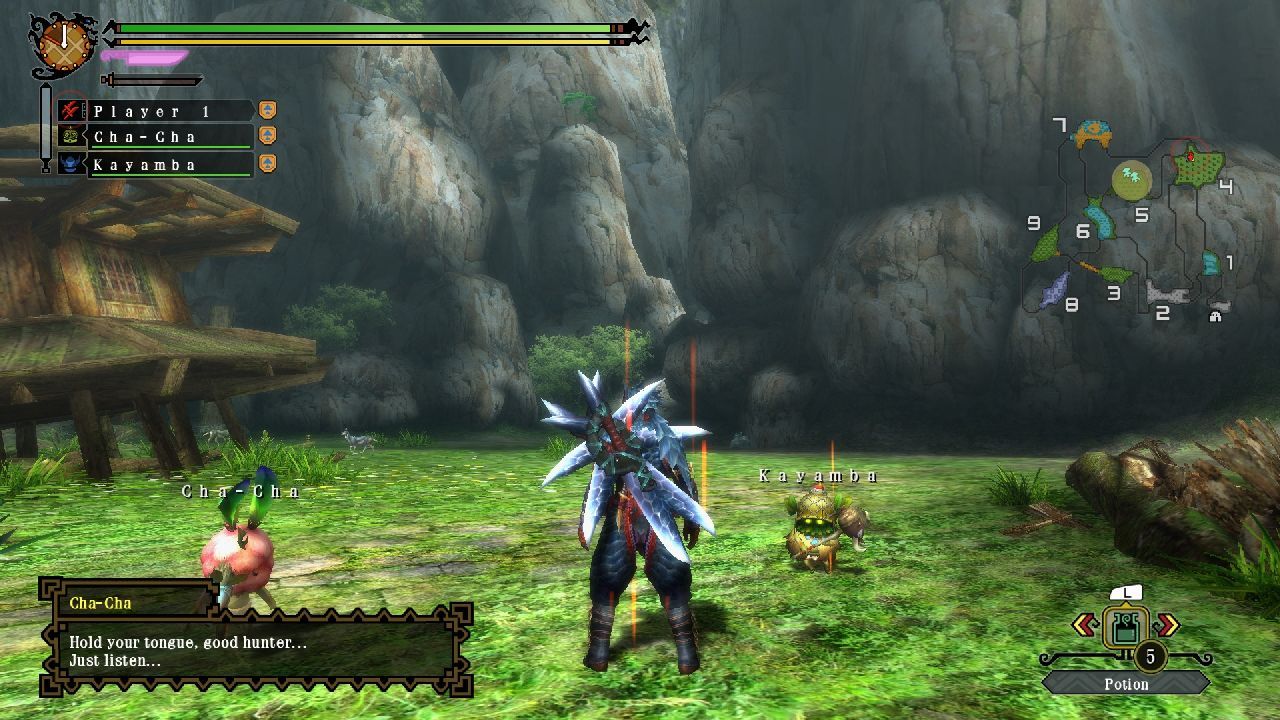Monster Hunter 3 Ultimate Review
Japanese-developed games have become something of a niche category these days. Considering that it was not too long ago when gamers were less frugal about a game’s country of origin, especially during the 8-to-16 bit era, this is a rather odd fact to consider.
It is because of this current cultural distinction that games like Monster Hunter have struggled to find an audience in the West. The long-running Capcom franchise is among the most popular titles of all time in Japan, but has long been considered too “hardcore” for Western gamers. Part of that can be justified for its unwieldy control scheme, as previous MH games were released exclusively for handhelds lacking a right analog stick for camera control, thus forcing diligent gamers to come up with the uncomfortable-yet-efficient “Claw” maneuver for controlling both the character and the camera with one awkwardly-positioned hand.

But with the Nintendo Wii release of Monster Hunter Tri, the series finally found a system that could accommodate its gameplay style more efficiently, even going so far as to come packaged with a controller with two analog sticks and four shoulder buttons. Though the Wii had often been criticized for its lack of software for hardcore gamers, it proved to be the system that would finally help the Monster Hunter brand increase its Western presence. With the newest HD re-release for the Wii U, Capcom is pushing to increase that recognition further with Monster Hunter 3 Ultimate, packing more content and better visuals as well as a more functional online experience. And with Nintendo’s newest system currently lacking in exclusive titles, the chances have never been better for the MH series to find a new audience.
The setting of Monster Hunter 3 takes place in Moga Village, an Eastern-influenced island port town filled with people in loincloths earning a living through fishing, farming, and trading. Their peaceful lives become threatened, however, when a series of earthquakes begin terrorizing the island; deducing that the cause of the quakes is from a massive underwater leviathan known as the Lagiacrus, the village chief has employed the help a hunter (your player character) to defeat the deadly sea creature, as well as assist the village with its growing monster problems.

Beyond that narrative setup, the story in Monster Hunter 3 is paper-thin, serving merely as a pretext for players to take their custom characters on quests involving monster-slaying and item-gathering. At first, you are given quests from the village chief and his son, exploring the Moga Woods while performing a variety of introductory tasks. Eventually, you will receive your tasks almost exclusively from the guild representative, instantly whisking you away to deserted wastelands, volcanic caves, frozen tundra and other elementally-focused areas and the monsters contained therein. Quests are offered in bulk which is listed by rank, and upon completing a requisite amount, your custom hunter will rise in rank, unlocking higher-grade quests featuring new monsters and rewards to claim.
On the surface, the gameplay seems simple enough; the majority of quests revolve around two tasks: hunting and gathering. Items can be obtained by foraging through plants, minerals, bones and other resource spots indicated by icon prompts. Taking down monsters also allows you to harvest their corpses for various parts, from scales to raw meat. Naturally, many of these collectibles won’t show their true value until they are combined with each other, such as combining herbs with mushrooms to create potions, or using a BBQ spit with raw meat to create steaks. Monster parts are also used mostly for crafting/upgrading new weapons and gear.

As simplistic as this all sounds, it is just a small taste of the numerous mechanics and systems involved that has kept Monster Hunter from being accessible for unfamiliar players. Nearly every single action requires knowledge of the game’s rules and restrictions to carry out effectively, and that starts with the combat. Many players may start the game believing they have the means to slaughter entire species within seconds, as they are immediately provided with weapons of various sizes and sharpness, only to learn that the game’s rules are much more restrictive. For one thing, there is no lock-on feature, requiring precise positioning in order to land an attack. There are also no life bars, HP numbers or other health indicators on any creatures. Every weapon handles differently as well, some that won’t allow for blocking attacks while others hinder movement due to their heavy size. Factor in a limited supply of restorative items, a decreasing stamina meter from consistent fighting and running and random attacks from other monsters while fighting the quest-specific target, and it quickly becomes obvious why this series is considered unapproachable for newcomers.
But the counterargument is that none of the mechanics are difficult to grasp. Indeed, it only takes a few play sessions to learn the basics of Monster Hunter, and after a day or so of playing those rules can become second nature, just as players had to first memorize the directional input for a Hadoken or to hold B and A to do a running jump. In truth, MH3 Ultimate is no more inaccessible or complex as most games, but it also does not do the best job of easing in new players; while the game does try to start things off slowly, and continues to offer tips and advice for most of its mechanics, it still fails to list the precise details that are crucial to the experience. One early quest, for example, teaches you how to capture monsters alive using a trap, but does not explain how traps are used nor how to craft them.
Fortunately, the internet is a treasure-trove of MH knowledge filled with numerous how-to videos, wikis and guides to fill in those blanks. In many regards, the game is similar to an MMO in the way that online databases exhaustively catalog all of the different items, weapon stats, elemental properties of monsters, and so on. Those guides will especially come in handy in order to find out how to obtain the necessary components to create a new piece of armor or to complete a gathering-related quest.
But even with all the online tutorials at your disposal, the best way to get better at Monster Hunter is to simply play it; as crucial as it is to prepare resources accordingly and learn the advantages and disadvantages of each piece of equipment, once the battle begins between a player and a snarling behemoth of a monster, it is the player’s skills that will determine victory or defeat. Much like the cult hit Dark Souls, Monster Hunter’s apparent lack of fluid controls are in fact a deliberate hurdle players must instinctively overcome. The concept of animation priority plays an important factor in both the weapons you can equip and the monsters you must face.

Rather than assign players with a specific class or job, as commonly seen in similar games, Monster Hunter determines what role characters will play based on the type of weapon they are wielding. Right from the start players are given access to all of the available weapon categories, but are only allowed to equip one at a time. And while logic may dictate that the biggest weapons do the most damage, none of the weapon types possess an advantage over each other. Instead, it all comes down to the player’s preferences over what pros and cons each weapon carries: the sword and shield set allows for quick strikes and the ability to block attacks, but loses its weapon sharpness very quickly (ultimately resulting in weaker attacks that may even do no damage at all, unless players use a whetstone to restore the blade’s edge); Greatswords are massive two-handed blades that can cleave through the thickest monster hides, but also cut down on the player’s movement speed significantly, including very slow swinging attacks; Bowguns can hit enemies from a safe distance, but require ammunition, which can be sold or crafted to shoot different status effects to hinder prey; Hunting horns act like massive clubs when used offensively, but can also be used as a support weapon by playing a combination of melodies to boost both the player’s stats as well as those of nearby allies.
In addition to learning how each weapon handles as well as the various attack combinations each one possesses (information that most certainly should have been represented in the actual game via a combo list or whatnot), it is also important to learn the attack patterns and tells of each monster. Many have attributed the Monster Hunter series as a “Boss Rush” series of games, and that distinction certainly qualifies. While the game features several smaller enemy types littered throughout each area, the real threats are the monsters players are tasked to hunt in each quest. Bigger, meaner, and more tenacious than any of the regular monsters, each of these boss monsters are unique in both design as well as behavior: some creatures like the Great Jaggi or Lagombi are known for their quick speed and close-range attacks, while others like the Rathian are massive dragons that can take flight and pelt players with fireballs from a distance. There are even creatures that behave differently in both land and underwater, such as the Royal Ludroth and the story-oriented Lagiacrus.

Any player who rushes in an attempt to take out these titanic terrors will soon find themselves incapacitated and wheeled back to their home base (losing a portion of the reward, though all items are kept). The key to victory is to assess each creature patiently, memorizing the patterns of their attacks and knowing when to roll away or counter with a blow to the head, similar to Punch-Out and other brawler-based games. Though none of the monsters feature a life bar, eventually they will begin to show signs of weakness, such as excessive drooling and limping. Don’t expect victory to immediately follow, however, as these creatures also tend to run away in order to lick their wounds, disappearing into another part of the area (which features different zones that are all linked together). Throwing a paintball prior to their escape will mark the creature’s presence on the mini-map, allowing players to track them down no matter where they’ve run off to, and perhaps re-supply some potions and rations along the way. Take too long to continue the fight, however, and the monster may regain some of its lost health by resting in a nearby nest or devouring some smaller carcasses.
These boss battles represent the defining appeal of the Monster Hunter series. All of the item harvesting and equipment preparation is in pursuit of the singular goal of hunting bigger and stronger monsters, gathering their parts to forge stronger weapons and armor, and those parts to outfit your character to take on bigger and stronger monsters. The unpredictable attacks and missing life bars result in some of the most intense battles ever experienced in any game, while the relentless pursuit of retreating enemies further extend the thrill of the hunt. The closest approximation to any previous game would be Shadow of the Colossus, and the shared rush of topping a massive titan after barely surviving its earth-shattering attacks. While the bosses in Monster Hunter do not possess any glaring weak points like the Colossi, they do have certain parts of their bodies that are susceptible to critical attacks. A well-timed Greatsword can cleave a creature’s tail clean off, while a hammer blow to the head can momentarily stun them into inactivity, or break off a horn or two. These dismemberments not only weaken monsters considerably, but also result in more monster parts to harvest, including rare pieces that can craft especially powerful weapons and armor. Fans of loot-driven games will come to know this monster-infested island as a paradise.
As lengthy and feature-filled as the singleplayer campaign is, the game’s true enjoyment come in the form of multiplayer. By talking to a certain NPC within the game, players can travel to a separate port town consisting of the usual shop vendors and blacksmiths, as well as three other players both online and off. When visiting the online port, all of the equipment and items gathered in singleplayer immediately carry over, and vice versa, making the pursuit of loot and equipment a persistent reward no matter what you are doing.
The only thing that doesn’t carry over is quest progress; the online port features its own list of quests to complete involving the same creatures found in singleplayer, but contain higher-ranking objectives that are only accessible to players who raise their ranks from the beginning tier of quests. As expected, the multiplayer hunts are significantly more difficult and require a dedicated team of players to work together and reap the rewards (every player who is present during completed objectives gets their own individual loot) .

In many ways, however, fighting with friends also makes things significantly easier. Monsters won’t always focus their attention on your character, often attacking each player at random. This allows for more breathing room to unleash attacks against the monster’s blind spots, or to momentarily retreat restoring lost health and stamina. Freeloaders could even hang back and not contribute at all to the fight and still stick around to seize materials from the fallen foe. While it is generally recommended to pull your weight for the sake of the team, prudence is still advised: quests will end in failure after three player deaths, regardless of who it is: if three players are killed each, it’s a failure. If one player dies three times, it’s a failure. This encourages everyone to give it their best in battle, and to especially learn what not to wear when taking on higher-ranking bosses (an equipment set with high defense, for example, can prove fatal against fire-breathing dragons if it also features a negative value for fire resistance) .
The multiplayer system isn’t as robust as other multiplayer-focused games, but it is functional enough. Multiple lobbies are available to join in or create, and can also feature room descriptions for specifically farming a certain enemy or to raise a certain Hunter Rank. The search can also be filtered to friends registered on the Wii U, though the game lacks the ability to send an invite to anyone playing singleplayer. Most annoying of all, anyone who joins a lobby where the other players are engaged in a quest may not be allowed to join the quest in progress, leading to many instances of entering a random room in the hopes that the group has not left to fulfill an objective, or waiting around in town asking when they will be finished. On the bright side, those unable to find a decent group online can still do the quests offline, and can also “hire” fellow players by registering their Guild Cards. Essentially AI copies of player data, these clones can be tasked to embark on their own quests for a set fee and deliver the rewards after some time have passed.
On the technical side of things, Monster Hunter 3 Ultimate marks the first high definition port of a Wii game. While no one will confuse the game for next-gen title, the sharper textures and more defined colors blend nicely with the already impressive art style as well as the brilliant monster animations; every creature, big and small, behaves like a natural exotic animal. In contrast, the animations on the human characters are deliberately stiff and cartoonish. While the custom player character looks noticeably low-poly up close, their wacky reactions prove quite amusing, whether from devouring food with rapid ferocity or running like a headless chicken when escaping rampaging monsters. The biggest technical fault, however, is the incredibly small text when speaking to villagers in town. While none of the dialogue is especially crucial to the experience, there is a copious amount of text that is expertly localized by the 8-4 department, making their written efforts feel like a waste unless players focus their eyes uncomfortably.

Currently, the game does not support off-TV play like many Wii U titles, although a patch is planned to include the feature along with cross-region play between North American and European players. What the game does allow out of the box is the ability to customize the Wii U gamepad to include shortcuts for many of the in-game tools; all of the items in a player’s possession, for example, can be displayed and used by touching a single bar, while another bar allows for quick combinations of materials. The gamepad can also house all of the HUD elements from the game, including the mini-map and health bar, allowing for a completely clear screen to further admire the visuals. These customizations can even be saved and loaded as presets, which can prove invaluable to expert players bouncing between different weapons and tasks, both online and off.
In the end, it is more difficult to describe how easy Monster Hunter’s learning curve is due to the countless number of features and mechanics, to which this review has described only a few. However, the sheer scope and scale of the game can be grasped quicker than it would first seem, especially when consulting an online guide or two. That said, if you are the type of gamer that prefers quick action games and less farming for materials, then this series may not be for you. Those seeking a unique and immersive experience that features unparalleled boss battles and thousands of different weapons and armor will eagerly sink their teeth into the hundreds of hours Ultimate will provide while lamenting over the many sleepless nights awaiting them.
